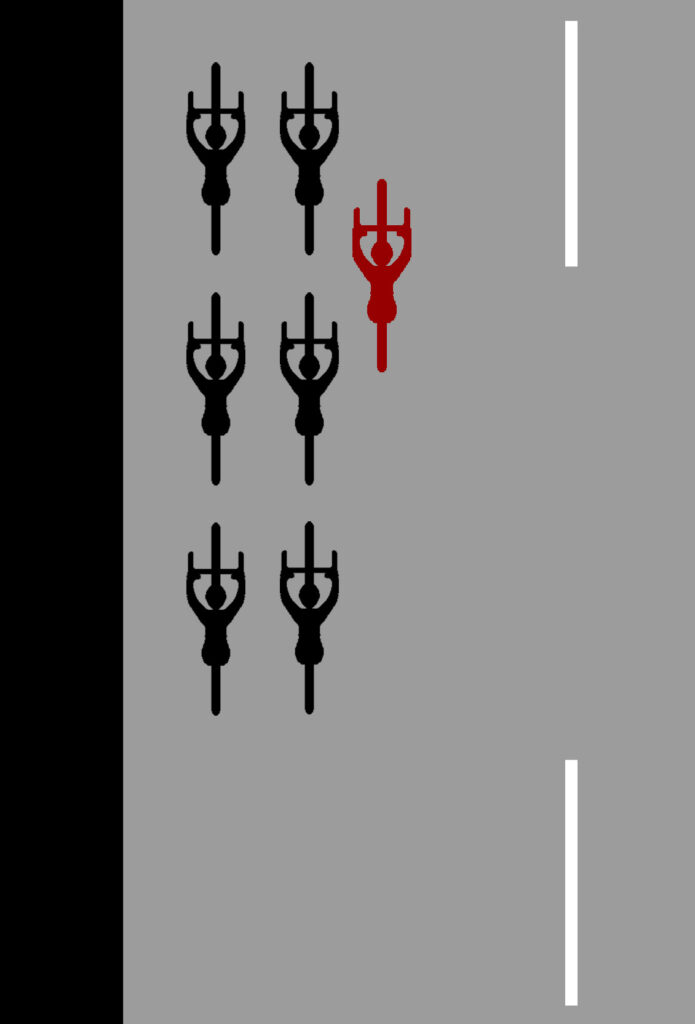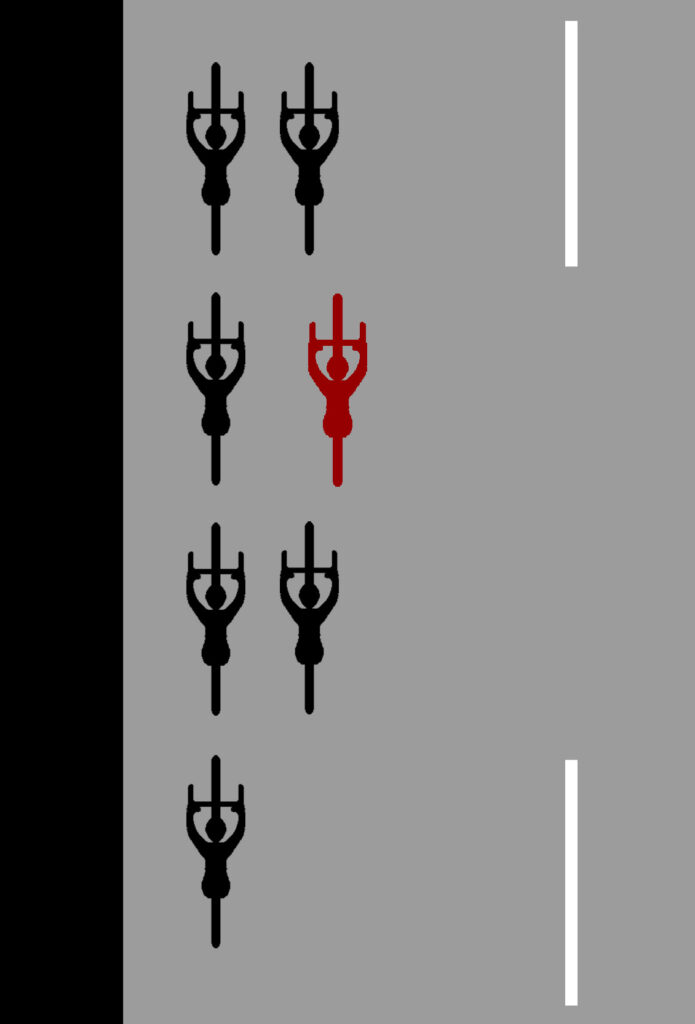Group riding is at the core of our cycling club. This guide gives an overivew of how to ride in a way that is legal, safe, efficient and considerate of other road users. Learning good etiquette is the key to becoming a valued member of our club.
Correct Road Position
The correct positions under most conditions is two lines of riders. The ride leader (green) sets the pace. The front riders are the eyes and ears of the group and are responsible for signalling hazards ahead. The rear riders are responsible for monitoring traffic approaching from behind and signalling accordingly.
Common Mistakes
Half wheeling
Half wheeling is being in front of the rider to the side. As well as being antisocial, it makes pacing more difficult. In the situation shown, the rider in red is half-wheeling the ride leader. If the leader compensates by speeding up it disrupts the speed of the entire group.
Wheel overlap/undertake
Wheel overlap is dangerous, increasing the likelyhood of a front wheel collision which is particularly difficult to recover from.
Missing rider
Where a rider is missing, the lone rider should ride in the left line. Riding in the middle is not in itself dangerous but it makes it impossible to close the gap without creating a problem with the group.
Three abreast
Riding three or more abreast is not permitted except when performing an overtaking maneuver.
Not following the wheel
The correct position is directly behind the rider in front. Riding to either side creates problems.
Not following the wheel
One of the problems of failing to follow the wheel is this scenario. As well as being equivalent to riding three abreast, if repeated, this leads to the group taking up more road space than necessary.
Leaving a gap
Leaving a gap reduces the efficiency of group riding and makes comminucation more difficult.
Riding in a single line
Under some circumstances it is better to ride in a single line. An example is on a narrow road where riding two abreast would make if unsafe for faster moving traffic to overtake. The call ‘single out’ can be made to do this, alternatively, when ‘car up’ is called by the rear rider, the group should form a single line.
To form a single line, the leftmost riders ease of the pace gradually, allowing gaps to form into which the right side riders can fit.
One common situation where it is not safe to single out is when it could encourage unsafe overtaking. Where an overtaking vehicle could not leave a clearance of at least 1.5m, or could not do so without straddling or crossing a solid white line, it is not appropriate to single out.
On extremely narrow roads with limited opportunities for overtaking, consideration should be given to pulling in left and stopping to allow faster moving traffic to pass. This should be signalled by the ride leader.
Overtaking
The rules of overtaking applicable to cyclists are details in sections 162-169 of the highway code.
Special care is needed when overtaking pedestrians, horse riders, other cyclists, motorcyclists and vehicles.
At least 2m clearance should be given to horse riders and speed should be reduced to 10mph or below. Avoid loud noises, in particular, take care not to freewheel as the noise can often startle horses.
Pedestrians walking in the road should be given at least 2m of clearance and speed should be kept low. The lead rider should call ‘Out’ to indicate pedestrians in the road.
The highway code omits mention of cyclicts overtaking motorised vehicles, but the situation does arise. In this case, the best guidance it to allow a clearance of at least 1.5m, more if the overtaking speed is in excess of 30mph.
Signals
Signals are essential for keeping the goup safe. Partcular responsibility is placed upon the frontmost and rearmost riders. The most common verbal and hand signal are detailed below.
Verbal Signals
‘Car up’ – car/vehicle approaching from behind. Called by the rear rider in a situation where the group should form a single line.
‘Car down’ – car/vehicle approaching from the front. Called by the leading riders in a situation where the group might need to take action.
‘Out’ – move away from the side of the road to pass an obstruction.
‘Steady’ – slow down.
‘Stopping’.
‘Single out’ – form a single line.
Hand Signals
Arm oustretched, palm down and moving up and down – slow down.
Arm outstretched, palm facing back, stationary – stop.
Arm outstretched, finger pointing – pothole/road defect.
Arm outstretched, finger pointing and rotating – turd.
Left arm behind back pointing right – move out.
Keeping the group together and waiting
The aim in a group ride is to stay together but there are times when this isn’t possible – for example on long climbs and long descents.
When a large gap has opened up, the ride leader should bring the group to a halt and wait for stragglers to catch up.
A returning straggler often needs time before setting off – to adjust clothing or to eat something for example, and the group needs to allow for this and not set off immediately. A returning straggler who does not need to stop should indicate it by continuing on past the group.
Equipment considerations
Machines should be in a good state of repair. Riders should carry a basic toolkit including the necessary spares and tools to repair a puncture.
Where rides are in darkness, or could reasonably extent into such times, light must be used. For group riding, a non-flashing rear light is prefferable.
For winter/wet rides the use of a bike fitted with mudguards is encouraged.









